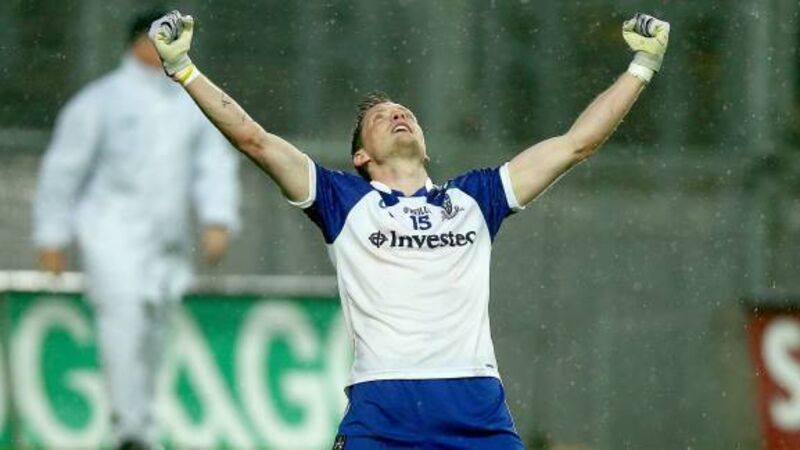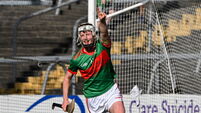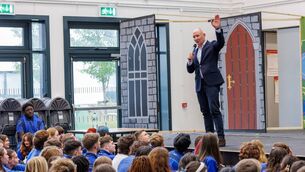There’s a reason why the football is better in March than June

A full 10 weeks on from the hurling championship exploding from the off with Austin Gleeson’s wonder goal and Cork’s stirring comeback the same day in Thurles, the football championship at last offered up a couple of games to thrill and intrigue the country.
The scoreboard in Croke Park last weekend often resembled one from Thurles or Wexford Park this summer; 1-19 to 2-15, 2-16 to 2-14, 1-20 to 2-10. Mayo-Cork and Monaghan-Kildare in particular was as good as sporting entertainment as you could find on television this weekend anywhere, and would even have rivalled anything on a weekend when there was a hurling game on as well.
But it’s been quite late to get going, hasn’t it? Just as it was last year as well.
Football might again produce at least one classic semi-final and another gripping final but for the third summer in a row the football championship in general for the months of May, June and July has been pedestrian, boring even, compared to the hurling.
Of course there have been decent games in the provinces and qualifiers. Fermanagh’s two games and losses were both entertaining shootouts. Tipperary were involved in a nail-biter against Cork and a couple of goalfests against Laois and Galway. But those ties didn’t demand national attention, they weren’t clashes of heavyweights, top-eight teams. Hurling by virtue of its top 10 teams being compacted into two provinces, routinely does.
The funny thing about it is, so does football — during the league. It might not mean as much but it offers better football and TV in those biting cold days in February, March and April than we get in early summer.
In spring, games like Cork-Mayo are routine. Take this past March. The first Saturday of the month you had Colm O’Neill make his comeback to kick a couple of points against the Dubs to give Cork a 1-17 to 0-18 win in a cracker in Croker. The next day Mayo and Kerry were neck and neck entering the last quarter before Mayo’s bench drove them home. A fortnight later Mayo beat Cork 4-12 to 2-14 in Castlebar. In the next round Dublin and Mayo had another thrilling shootout and draw under the lights in Croker.
All but a couple of those games were on live TV, all were games where football people and those only casually interested in the sport could say: “Did you see that game last night?”
It might not be as important as what transpires in the summer but the reality is what Setanta and TG4 broadcast through the spring is better football and TV than most of what RTÉ has to churn out in the first three months of the summer.
The best sides are kept away from one another, unlike in hurling; instead scattered to the provinces. Tradition has seen to that and very likely tradition will maintain that for probably the rest of a decade until a generation of administrator retires or, to be more succinct and blunt about it, dies out.
Undoubtedly there is a certain comfort and familiarity and rhythm to the current football calendar that certain teams and indeed Irish life can set its clock by: early rounds in May and June, provincial finals and qualifiers in July; quarter-finals and semi-finals in August, followed by the big one in September. Unfortunately in trying — unsuccessfully — to do every county a favour with the current format, the administrators are doing football itself a disservice.
The game needs to see its better teams playing each other more often throughout the summer, not just at the end of it. There’s only so long people are going to put up with RTÉ and the provincial councils forcing upon the nation Donegal thrashing Antrim and the Dubs blitzing Wexford while not giving them a chance to see Cork go up against either of those winning sides.
We’ll say it again. Run a provincial league instead of a National League in the spring. Run off the knockout provincial championships by the end of May. Then, like every county in the country has, roll out a senior and intermediate All-Ireland championship; 16 teams in each, with pools of eight teams. Everyone has three games at home, three on the road and one possibly in Croke Park. The top team in each pool goes through to the All-Ireland semi-final. Second and third make the All-Ireland quarter-final play-offs. Three teams go down to intermediate, three teams come up.
Everyone wins. Clubs know when they’re out because they know when the county is out. Roscommon can still aspire to winning a Leinster while playing, maybe even upsetting, the likes of Tyrone and Cork.
The big guns play each other regularly without knowing they’ll make it to August, just as they don’t know for much of the spring if they were going to make it to the knockout stages of the league.
Until that happens, keep expecting better football games in March than June.











